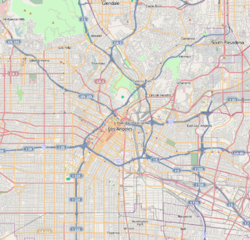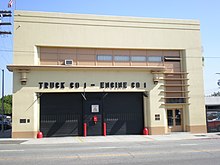world.wikisort.org - USA
Lincoln Heights is one of the oldest neighborhoods in Los Angeles, California, United States. It was originally called "East Los Angeles" from 1873 to 1917. It is a densely populated, mostly Latino and Asian neighborhood. It includes many historic landmarks and was known as "the Bedroom of the Pueblo".
Lincoln Heights | |
|---|---|
Neighborhood of Los Angeles | |
 View of Lincoln Heights and Downtown Los Angeles from the Repetto Hills | |
 Lincoln Heights boundary map | |
 Lincoln Heights Location within Central Los Angeles | |
| Coordinates: 34.073597°N 118.209627°W | |
| Country | United States |
| State | California |
| County | Los Angeles |
| City | Los Angeles |
| Time zone | UTC-8 (PST) |
| • Summer (DST) | UTC-7 (PDT) |
| ZIP code | 90031 |
| Area code(s) | 323, 213, etc |
History

Yaangna Village was located on what is now the current day site of Downey Park on Albion and Avenue 17. Lincoln Heights is considered to be one of the oldest neighborhoods outside of La Placita / Sonoratown dating to the 1870s and is found wholly within the original Spanish four leagues pueblo of the Los Angeles land grant. Located on bluffs overlooking the Los Angeles River and immersed in the floodplain, Lincoln Heights river adjacent land became the city's first Industrial Corridor. Aided by slave labor of the Kizh, it later became the home to some of the city's most notable downtown industrialists, who built numerous Victorian homes, some of which have been preserved under the city's historic preservation ordinance.[1]
Historically, It was called East Los Angeles dating back to 1873. In 1863, John Strother Griffin purchased 2,000 acres of ranch land for $1,000 and in 1870, Griffin and his nephew, Hancock Johnson, built homes there. In late 1874, they offered an additional 35 acres for sale, subdivided into 65 by 165 foot lots for $150 each. The neighborhood was known as "East Los Angeles" for 44 years until 1917 when residents voted to change the name to Lincoln Heights.
The area was the first suburban neighborhood of Los Angeles, having been subdivided in 1873. Lincoln Heights was well located to serve as a home for people who worked in the industrial areas lining the Los Angeles River and wanted to live upstream. By the late 1880s a neighborhood commercial district had been built around the intersection of North Broadway and Truman Streets, with business buildings such as the Hayden Block. This is identified as the first suburban neighborhood shopping district in Los Angeles; it was demolished in the mid-20th century to make way for I-5, the Golden State Freeway.[2]
Thereafter, what would be known as North Broadway became a crowded commercial thoroughfare, and by the turn of the 20th century, unfettered industrial construction and numerous rock crushing operations within the once scenic floodplain made it less appealing for Angelenos of means, who moved out first to the Arroyo Seco area and Hollywood, then (from the 1920s onward) to rapidly developing Mid-Wilshire. As wealthy residents departed, Lincoln Heights became home to a large Italian American population,[3] as well as some Irish American and French American (the 1850s era immigration) residents by the 1930s, also a wave of poor white American residents known as "Okies" from the Great Plains moved into the area. With an increasingly large Mexican American population, Lincoln Heights became a 'barrio by the 1960s. It and its cross-river neighbor "Little Italy" (what is now Chinatown) formed the heart of southern California's Italian-American community.
In the 21st century, Lincoln Heights has slowly been gentrifying due to Los Angeles' land use policies.[4] Activists claim the LA River revitalization, the Cornfield Arroyo Specific Plan, and the upzoning of previous industrial land (oldest industrial corridor in the city) for luxury housing threatens the health, safety and welfare of an historically vulnerable community.[5][6]
Demographics
Based on the 2019 Census estimates, Lincoln Heights has a population of 39,916 residents.
The neighborhood has a relatively high percentage of both Latino and Asian residents. The breakdown was Latinos, 66.2%; Asians, 23.4%; whites, 7.8%;[7] blacks, 0.4%; and others, 1.0%. Mexico (57.0%) and Vietnam (16.9%) were the most common places of birth for the 55.8% of the residents who were born abroad—which was a high percentage for Los Angeles.
The median yearly household income in 2008 dollars was $30,579, considered low for the city. Renters occupied 75.9% of the housing stock, and house- or apartment-owners held 24.1%. The average household size of 3.6 people was considered high for Los Angeles.
The percentages of never-married men (53.0%) and women (40.6%) were among the county's highest. The 19.5% of families headed by single parents was considered about average for city neighborhoods. There were 500 veterans, or 2.8% of the population, a low proportion compared to the rest of the city.
Lincoln Heights ranks in the 94th-100th percentile of environmentally burdened communities according to CalEnviroScreen 4.0 [8]
Arts and culture
Public libraries

The Lincoln Heights Branch of the Los Angeles Public Library is on Workman Street.
Landmarks
- Lincoln Park
- San Antonio Winery, (founded 1917), oldest operating business in Lincoln Heights
- Los Angeles Alligator Farm
- Selig Polyscope Company
- The Brewery Art Colony
- Church of the Epiphany, oldest operating Episcopal church in Los Angeles; Cesar Chavez gave speeches in the church hall and La Raza was printed in the church basement
- Lincoln Heights Jail
- Heritage Square Museum
Education
Just 5.5% of Lincoln Heights residents aged 25 and older had earned a four-year degree by 2000, a low percentage for the city.
Schools
Public
- Abraham Lincoln High School, 3501 North Broadway
- Academy of Environmental & Social Policy (ESP) at Lincoln High, 3501 North Broadway[9]
- Hillside Elementary School, 120 East Avenue 35
- Alliance College-Ready Middle Academy No. 5, charter, 2635 Pasadena Avenue
- Pueblo de Los Angeles Continuation School, 2506 Alta Street
- Gates Street Elementary School, 3333 Manitou Avenue
- Albion Street Elementary School, 322 South Avenue 18
- Griffin Avenue Elementary School, 2025 Griffin Avenue
- Milagro Charter Elementary School, 1855 North Main Street
- Los Angeles Leadership Academy High School (LALA HS), 234 W Avenue 33
- Alliance College Ready Middle Academy #5 (ACRMA #5)
- Alliance Susan & Eric Smidt Technology High School
- East Los Angeles Skill Center (Adult Education), 3921 Selig Place [10]
PUC Schools operates the Milagro Charter School (K-5) and the Excel Charter Academy (6-8) in Lincoln Heights.[11][12][13]
Private
- Little Flower Missionary House, elementary, 2434 Gates Street (closed August 31, 2017).
- Sacred Heart High School, 2111 Griffin Avenue
- Sacred Heart Elementary School, 2109 Sichel Street
Infrastructure
Transportation
Major thoroughfares include Valley Boulevard; Mission Road; Pasadena Avenue; North Main, Marengo, Daly, and Figueroa Streets; and North Broadway. The Golden State Freeway (I-5) runs through the district, and the Metro L Line has a station in the far northwestern portion of the district.
Fire services

Los Angeles Fire Department Fire Station No. 1[14] is located in the Lincoln Heights area. The station is in the Battalion 2 district.
Healthcare
The Los Angeles County Department of Public Health operates the Central Health Center in Downtown Los Angeles, serving Lincoln Heights.[15]
Notable people
This section does not cite any sources. (August 2022) |
- Frank Capra, film director
- John Strother Griffin, the founder of East Los Angeles
- Kenny Washington, football player
- Cesar Chavez, during the "No on 22" campaign in November 1972, he temporarily resided in Lincoln Heights at a private residence on corner of Workman and Baldwin streets
- Daniel Lewis James, author
- Eldridge Cleaver, Black Panther Party's Minister of Information
- Gregory Ain, architect[16]
In popular culture
- Police (1916)
- Take a Chance (1918)
- Detained (1924)
- Assault on Precinct 13 (1976)
- A Nightmare on Elm Street (1984)
- Blood In Blood Out (1993)
- Changeling (2008)
See also
- Los Angeles Historic-Cultural Monuments on the East and Northeast Sides
References
- Garner, Scott (January 25, 2019). "Neighborhood Spotlight: Lincoln Heights was L.A.'s first suburb". Los Angeles Times. Retrieved July 27, 2019.
- Los Angeles Citywide Historic Context Statement. Context: Commercial Development, 1859-1980. Theme: Neighborhood Commercial Development, 1880-1980. Prepared for: City of Los Angeles Department of City Planning Office of Historic Resources (August 2017)
- Hernandez, Samanta Helou (April 9, 2019). "Exploring Main Street in Chinatown, Lincoln Heights". Curbed LA. Retrieved December 24, 2020.
- Valdez, Jonah (April 30, 2022). "A long-forgotten toxic dump site is raising new worries for this Los Angeles neighborhood". Los Angeles Times. Retrieved May 2, 2022.
- "Who Moved East L.A.?". KCET. Retrieved 2011-11-18.
- Winton, Richard (July 27, 2019). "LAPD officer out with girlfriend fatally shot at taco stand in Lincoln Heights". Los Angeles Times. Retrieved July 27, 2019.
- "90031 Demographics - Get Current Census Data for 90031, CA". www.california-demographics.com.
- https://experience.arcgis.com/experience/11d2f52282a54ceebcac7428e6184203/page/Draft-CalEnviroScreen-4.0/ [dead link]
- "Where Passion Meets Education". ESP Magnet. Retrieved March 22, 2020.
- East Los Angeles Service Area (ELASC) Archived 2014-11-09 at the Wayback Machine
- "Milagro Charter School Archived 2011-12-06 at the Wayback Machine." PUC Schools. Retrieved on November 27, 2011.
- "Excel Charter Academy Archived 2008-05-15 at the Wayback Machine." PUC Schools. Retrieved on November 27, 2011. "Excel Charter Academy 1855 North Main Street Los Angeles, CA 90031-3227"
- "Contact School Milagro Charter School Archived 2008-05-15 at the Wayback Machine." PUC Schools. Retrieved on November 27, 2011. "Milagro Charter School 1855 North Main Street Los Angeles, CA 90031-3227"
- "Los Angeles Fire Department — Fire Station 1". Archived from the original on March 13, 2009.
- "Los Angeles Department of Public Health — Community Health Services".
- "Gregory Ain | Los Angeles Conservancy". www.laconservancy.org/architects/gregory-ain.
External links
Другой контент может иметь иную лицензию. Перед использованием материалов сайта WikiSort.org внимательно изучите правила лицензирования конкретных элементов наполнения сайта.
WikiSort.org - проект по пересортировке и дополнению контента Википедии
